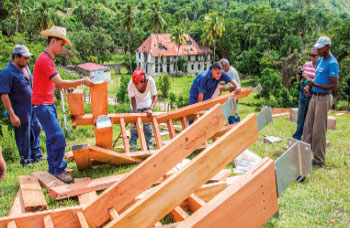 Coffee cultural landscape also affected the process of recognition and awareness of being born in Santiago
Coffee cultural landscape also affected the process of recognition and awareness of being born in Santiago
The transformation of the natural landscape of the mountainous areas close to Santiago de Cuba, boosted by the coffee implementation prompted the assimilation of these territories as constituent elements of local identity. The city, which had looked to the sea, began to perceive the mountains as not only an economic resource, but also cultural and of identity. This moment was very important in the process of recognition and awareness of being born in Santiago.
The material evidence still exists in the archaeological landscape formed from the ruins of the coffee plantations, promoted by French immigrants in the early decades of the nineteenth century. Mountainous areas, that surround Santiago de Cuba, provided fertile soil and a climate suitable for growing grain; in them the location of the settlement were carefully chosen by the owner for the better use of natural resources, which is why various spatial distributions were perceived.
The architectural components were determined by their production and / or domestic roles within the agribusiness system. For manufacturing materials extracted from the natural environment were used, such as limestone that was obtained from quarries near the settlement and was used in blocks or processed in the kilns to make the necessary lime for the mortars. The use of abundant water in the industrial process of coffee was the key to success of French farmers, who, using the instructions manual of experts of the time and their own experiences in Saint-Domingue, built extraordinary works of hydraulic engineering to ensure production of the farms.
In its essence, the slave plantation system implies the coexistence and confrontation between two cultural areas: the landowner and slave; both made permanent contributions to the historical memory of the town with its actions in the territory. The multiple aspects transmitted to the memory of the town by the coffee culture originated from the French immigration to Santiago de Cuba have transcended national borders to be instituted in two paradigms of tangible and intangible heritage of humanity: the Archaeological Landscape of the first coffee plantations in southeastern Cuba and the Tumba Francesa "La Caridad de Oriente".
Taking as starting point the historical development, the center of the action is coffee from all points of view: tangible and intangible heritage, agriculture, tourism product as a source of own resources for the sustainability of action in time. Hence the interest of realizing the Los Caminos del Café project within an appropriate action and allows uniting both local people and tourists, including a strong interaction with the private sector, emblematic and symbolic material elements that must be preserved: the Fraternity plantation and the four ruins circuit in rural area, as well as the Dranguet house in the urban area.
To obtain this result Malongo Foundation, the European Union and the Office of the Curator of the City of Santiago de Cuba collaborate in conjunction with a number of Cuban and foreign institutions and associations related to the interests and actions of the project.
And of course, tourism plays a key role in the success of the project. Indeed, as was the coffee in the past, tourism is currently at the center of economic and cultural exchanges, but meets international requirements that impact the whole action (aesthetic, customer, and nature of goods and activities cultural, management, promotion of local, national and international level). These requirements have a direct impact on the training undertaken in this regard in the area and are part of the new opportunities provided by economic and social guidelines implemented by the Cuban government, which are set forth in the form of promoting nature tourism, heritage and adventure.
Tourism activity will also allow the creation of funds for the process of heritage conservation and the development of the tourism product, as is done today in the historic center of the city of Santiago de Cuba.
It all starts with restoring fraternity, its garden, the nearby ruins, roads that connected with the whole town, with the port, with the world. Symbolically, these roads linking every sector of Cuban society with each component element of the project to meet the objective of economic development, based on heritage and culture, supported by responsible tourism.
Related Publications

How Harumi Yamaguchi invented the modern woman in Japan
March 16, 2022
Giovanni Duarte and an orchestra capable of everything
August 26, 2020











